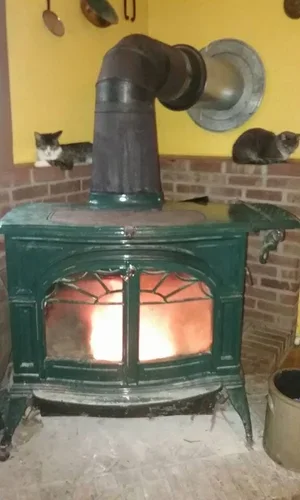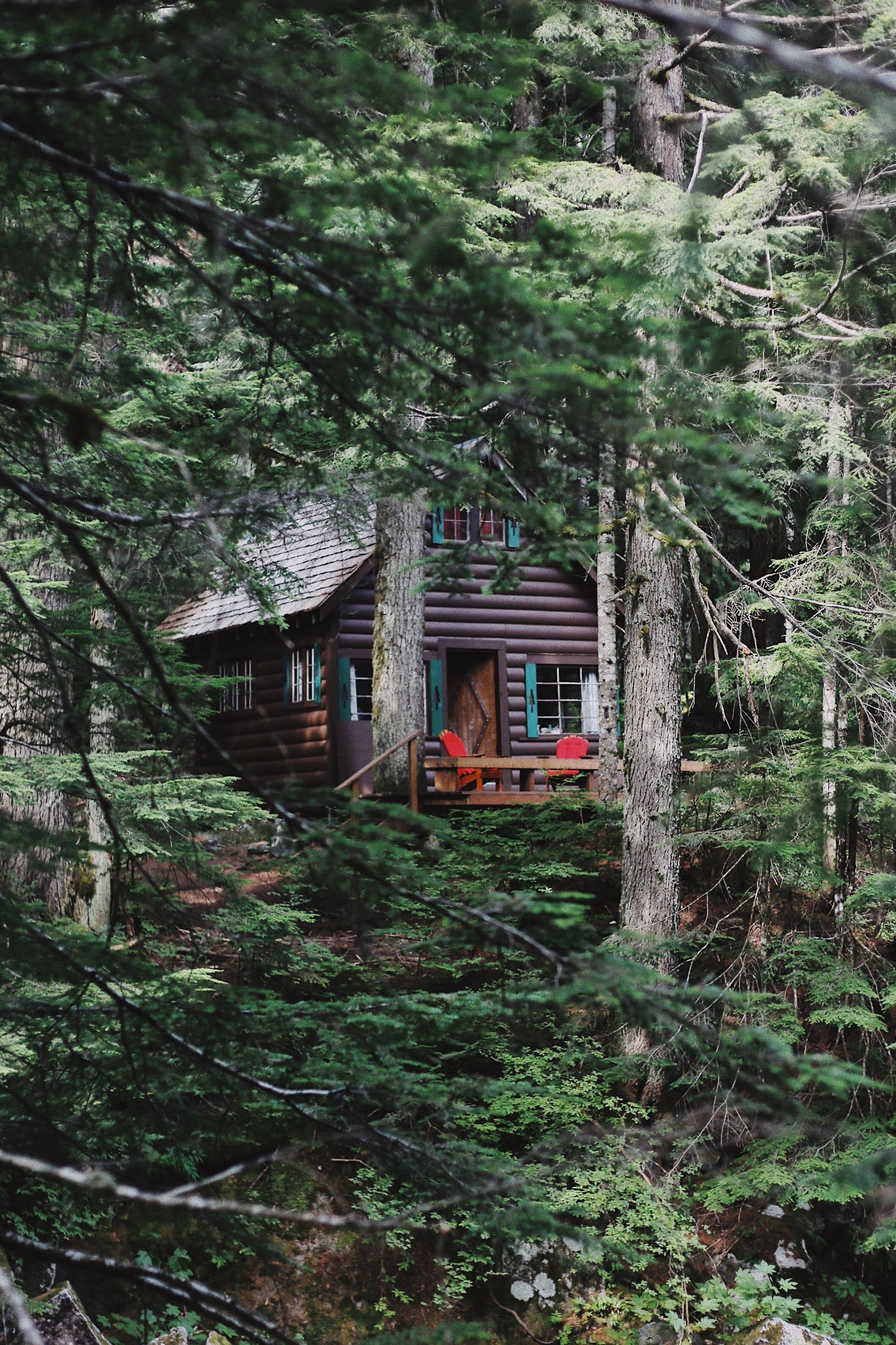Off-grid living brings a number of challenges on how to meet our basic needs. One of them is heating your home in the winter. Wood heat and propane are the two most popular options when you live off-grid. You can choose one over the other or use both.
As in my article comparing solar versus propane refrigeration, I am going to give you my tips and experiences based on my 29+ years of living off the grid.
There are many advantages and disadvantages to both wood and propane. Let’s compare them.
My cats LOVE woodstove heat!
Wood Heat
I love wood heat. It appeals to me emotionally and physically. As a child, we always had fireplaces or inserts and my father loved cutting wood. He still does, at 80+ years old, he cuts his own wood to enjoy a fire.
Advantages of Wood Heat
Warm heat that radiates into the room
Does not add moisture to the room
Security and independence especially if you have a woodlot
Renewable – keep planting trees and manage your woodlot wisely
Hold their value and used ones available on the market
You can heat water and cook on a wood stove.
Disadvantages
A significant amount of labor and time to cut and chop and/or split wood
Purchased cordwood adds expense
You must “learn” your stove.
Needs to be monitored. Fires do go out and need to be started again.
High-quality woodstoves can be pricey. Don’t skimp on safety!
Insurance costs can be higher if you have a wood stove.
Both wood and propane have pros and cons for off-grid cabins. Here are my experiences using both so you can make an informed decision.
Wood Heat
Physically wood heat is warm. Wood produces radiant heat which spreads out and warms the room. It just feels so good and makes me feel relaxed. One of my favorite activities in winter is curling up by the woodstove and looking at seed catalogs.
But practically speaking wood heat is a lot of work.
The saying goes that wood heat warms you twice. The first time when you cut and chop it, the second time when you burn it.
There is no denying wood heat is a lot of work. So part of the question you may need to ask yourself - is wood heat worth the effort?
The cost depends a lot on whether you harvest your own wood or buy firewood. Also very important: wood species (hardwood vs softwood), moisture content, how well it’s seasoned/dried affects how much heat you actually get.
You may want to consider expenses. Do you have a wooded area or have access to a woodlot? Labor may be well worth the effort when the product is free. In addition, you may consider a wood split with someone.
A wood split has one person with available wood on their property and the other person willing to cut wood for half of the supply. This can be a win-win for both parties.
Wood and the Environment
I have people that are frequently surprised I heat with wood because they view it as a dirty source of heat. Many of the newer stoves on the market are actually EPA regulated and have a catalytic converter. Simply put a catalytic converter re-burns the smoke from the fire and reduces the output of pollutants.
Wood heat is a renewable resource. For every tree I burn, I plant two more. In fact, Fox Run EEC has contributed to many tree-planting organizations for our community outreach.
In addition, when taking trees from your own property you can be a good forestry manager and remove trees that are in ill health, blocking a more valuable tree or in a poor location. For example, that means we have been burning a lot of Ash trees that have succumbed to the emerald ash borer.
Keep in mind that some dead trees are ecologically beneficial to the forest. A healthy forest needs a diversity of tree species and trees of various ages.
Wood also has the advantage of supporting the local economy. Wood stoves and cordwood are not things you can easily buy online. You buy them locally.
Propane Heat
There are several types of propane heaters. They fall into three broad categories. Unvented, Vented, and Central units. The division is pretty self-explanatory.
Advantages of Propane
Most units do not require electricity.
Convenient.
Less monitoring, don’t have to add fuel.
Most have either a manual temperature setting or a thermostat to regulate the heat.
Great for when you are at work or go on a vacation.
Disadvantages
Can be expensive.
Fuel prices do vary with the global economy.
Rely on someone to come to you and add fuel to your tank. This may be difficult if you live in a rural area on a gravel road.
Is a fossil fuel, pollutes the environment, limited resources, and is not dependable.
Unvented heaters
An unvented heater hangs on the wall or sits on the floor and attaches to an outside source of propane from a copper pipe. You can also get small portable ones such as a Mr. Buddy that heats up to 450 square feet.
Initially, I used this wall-mounted unvented heater. They are easy to install, use no electricity and are great for small places. However, they are not very economical and you are not supposed to use them in closed in living spaces due to the risk of Carbon Monoxide (CO) poisoning.
If like me you use them in a cabin follow the manufacturer’s instructions, have a room with good air circulation (mine was downright drafty) and have several CO monitors in the home. When shopping for a propane heater, look for safety features that have the unit shut off if carbon monoxide or lack of oxygen is detected.
One Problem I Had
I will say one problem I had with propane heaters was the ignition switch getting clogged from dust. This was not a problem with the unit but because my house was so dusty. Between plywood floors and constant construction, everything was dusty! In the warm weather, I wrapped the unit in a blanket to keep it cleaner. Then I would use a straw to blow out the dust before igniting.
Vented heaters
Vented heaters need to be attached to a vent that goes outside. This allows them to Vent fumes and not release CO2 into the room. They initial expense is higher with a vented heater.
After my cabin was totally enclosed and insulated I moved onto this type of heater. It heated my 600 square feet well and later after we made an addition to the cabin which brought us to 800 square feet.
It worked well but the expense was high, even with it on low. In the heaters defense, I will say that I also ran a propane refrigerator and propane cooking stove as well. However, I could really see the jump on the main propane tanks gauge when the heater had been going several days.
I was working an outside job teaching in those early years so the propane heater kept the house warm when we were away. In the evenings and on weekends I had the woodstove going and was able to put the heater on just pilot light. This helped with lowering how much fuel I needed to buy.
Central Heat
Central units are more popular with larger contemporary houses. Many of us that are off-grid have smaller homes and smaller heating systems. However, central units are a consideration. They involve a higher cost and hirering an HVAC tech who is licensed to install units. We will not be discussing these in-depth because they are beyond my area of expertise.
Using Both Propane and Wood
Using both can work well especially if you work outside your home. A propane heater can keep the house at a comfortable level (or above freezing) when you are away. This is good for your appliances and any pets or plants you may have inside.
When you come home and on days off you can fire up the wood stove and enjoy warm cheap heat.
You can see by this graph representing cost comparison in Maine that even when you purchase cord wood it is the cheapest heat.
Propane Expenses
The cost of propane depends on your region, delivery costs, tank rental or ownership, and seasonal spikes. Propane costs money and I have told the story several times of how the propane company would charge me for a tank of propane every six months whether I used the gas or not. No rewards for being energy conservative here! Just lots of rental fees and refuel fees whether you need propane or not.
Propane is a fossil fuel. I am trying to minimize my dependence (there’s that word again) on fossil fuels. They are bad for the environment and the future of this planet.
Comparison of Prices
I compared the prices in Wisconsin and Kentucky for an example. (prices based on what they were in November 2025)
Wisconsin
Propane price
Wisconsin’s average was ≈ US $1.74 per gallon for the week of Nov 3 2025.
The National Council of Energy quotes $1.73 per gallon in early November 2025.
For a homestead using say 1,000 gallons in a year (just an example), that’s about $1,740 in fuel cost (excluding tank/installation/etc).
Note: delivery in remote/off-grid areas may add a premium, and usage will vary depending on home insulation, size, climate, etc.
Cordwood price
Wisconsin Firewood Sales lists: kiln-dried hardwood — $465 for 1 full cord, 2 cords for $930. Semi-seasoned wood: 1 cord $350.
National data suggests a full cord runs ~$150-$500 depending on location/wood type.
Kentucky
Propane price
Residential propane in Kentucky was quoted at ≈ US $2.47 per gallon for the week of Nov 3 2025.
National Council on Energy states $2.46 per gallon as of early Nov 2025.
So for a similar 1,000-gallon annual usage, that’s ~$2,470 just for fuel (again excluding hardware/installation).
For off-grid you might use less or more depending on climate, envelope, backup systems, etc.
Cordwood price
Kentucky cords of wood “range from $250-$500 per cord” depending on location and wood type.
So if a homestead uses 3 cords per winter, fuel cost could be ~$750-$1,500 (assuming purchase).
If self-harvested, costs lower but labor/time becomes significant.
I spent 29 years homesteading and living off grid using solar power and a rain catchment system. This is my list of Pros and Cons for living a self-reliant lifestyle.
House Design
House design is an important factor when it comes to heating your home. This was something I actually learned by trial and error.
Our build was a rather slow process. I was buying building materials as I went so as not to accrue any debt. My son (who was nine years old when we began) and I got up the frame and had one room enclosed by the first winter.
I purchased the ventless propane heater I talked about above and that is what we used that first winter. It worked fine to heat the room although was a bit pricey seeing as how we were heating one small space.
When we finished enclosing the cabin the next year it was 20X30 (600 square feet ) that contained basically four rooms - 2 bedrooms, a very small bathroom, and an open kitchen living room area.
My plan had been to put a wood stove in the middle of the home in that open living space. A good friend explained to me that it was not a good place to put a woodstove for safety, efficiency, and traffic flow reasons. They were right of course, it would not have worked.
So I placed the woodstove in the back corner of the living room This location was easy to vent and safe because people and animals would not bump into or trip over the stove. However, I will say that it is not the best location to spread the warmth. You can always use a fan to help spread the warm air around the home.
Insulation, having quality windows and chalking can all help make your home more energy efficient.
Check out our website Store and Resources page for free downloads and PDF books
Author, Ame Vanorio has 29 years of experience living off-grid, and is a certified teacher. She is the director of Fox Run Environmental Education Center, an author and licensed wildlife rehabilitator.








Setting up a Geothermal system is one way you can harness clean energy directly under your feet. If you are thinking about heating, ventilation, and air conditioning while off-grid, then you are thinking of Geothermal energy.